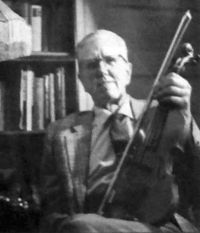Biography:Joe Pancerzewski
Joe Pancerzewski
| |
|---|---|
| Given name: | Joe |
| Middle name: | |
| Family name: | Pancerzewski |
| Place of birth: | Minnesota |
| Place of death: | Edmonds, Washington |
| Year of birth: | 1905 |
| Year of death: | 1991 |
| Profile: | Composer, Musician |
| Source of information: | voyagerrecords.com |
Biographical notes
Joe Pancerzewski's family homesteaded near White Earth, North Dakota in 1909. As a boy he learned to play from his neighbors, especially the four brothers in the Nelson family. As Joe put it, "that area was plastered with good fiddlers". When he was a teenager he rode horseback for miles to play for local old time dances. The repertoire consisted of square dances, waltzes, polkas, and schottisches. In 1921 he went to Regina, Saskatchewan, where he met violinist and band leader Frances Kelly who told him "Kid, you're a pretty good fiddler but you'll never amount to nothing until you know how to read music." Joe said "I never amounted to nothing anyhow, but he taught me how to read music, and it was a godsend to help. I found out that there were a lot of places on the fiddle I never knew about." He joined the dance band and began playing "hot" foxtrots, travelling all over Western Canada. At this time he also started to learn the Canadian fiddle style for which he is known. When he moved to Bellingham, Washington in 1924, he continued to play the popular music of the day with large dance bands. He also played with the theater orchestra at the Pantages, and occasionally performed a "Yankee Fiddler" novelty solo act.
In 1927 he went to work for the railroad, which drastically cut into his fiddling, and when he was promoted to engineer in 1939 he put the fiddle away in a trunk. While he was railroading he also became a skilled pool player, and he used to relate amazing stories about railroading, pool playing, and smuggling illicit liquor from Canada into the US during Prohibition. When he retired from the railroad in 1970, he dug out his fiddle and went to the State Fiddle Contest sponsored by the Washington Old Time Fiddle Association. Within a year he became virtually unbeatable in local fiddle contests and in the Senior division of national contests. As Joe put it, "I kept up practicing for a year, and I fooled a lot of people." He became an important stylistic influence and an inspiration for many fiddlers in the Northwest and in other parts of the country. In 1976 he represented Northwest fiddling at the Smithsonian's National Folk Festival in Washington D.C.
During his long musical career, Joe absorbed tunes and techniques from every fiddler and violinist he heard, drawing from such varied styles as traditional North Dakota dance tunes, Western Canada, early jazz, classical, bluegrass, and Texas contest fiddling. But he managed to make everything he played his own. His was basically a dance-oriented Canadian style.
Joe emphasized the importance of good timing and of giving every note its full value. He was also a master of expression, and said that a waltz should be played as if it were a love song, or to tell a story. What Joe called the "critical notes" of a tune are the notes that define that tune and distinguish it from other tunes. He said that these notes should be emphasized, and never totally obscured by variations. He had strong opinions on the subject of improvisation. "You've got to know where to do it. Joe Venuti was a master at it. He was a great violinist. A few hot licks and a little run, and it got right back into the melody." [Vivian Williams]
